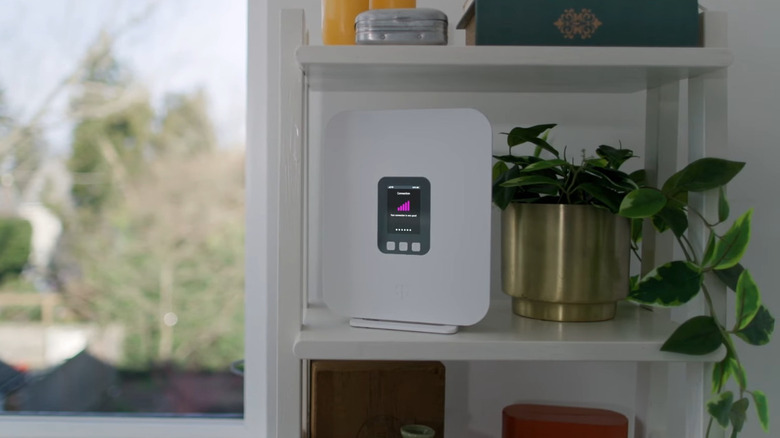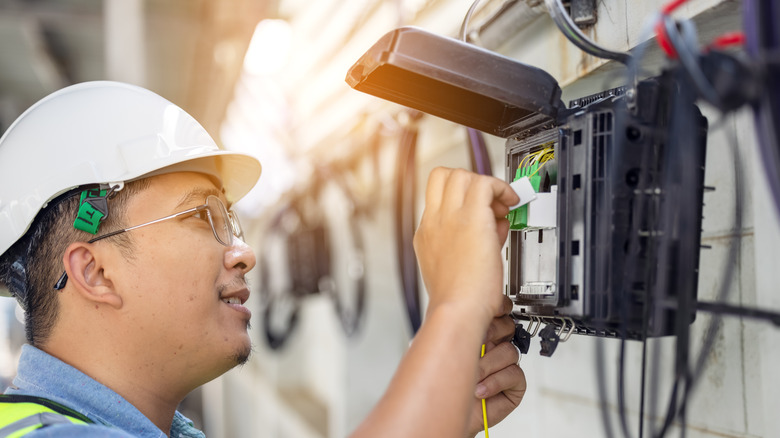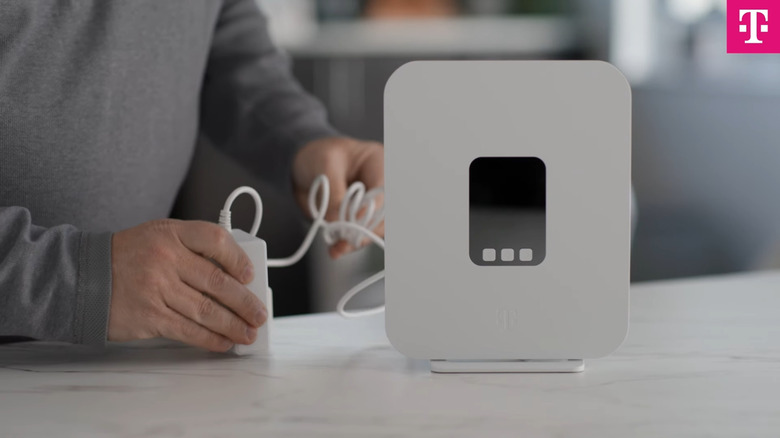T-Mobile Fiber Vs. 5G Internet Service: What's The Difference?
For years, T-Mobile's home internet offerings have been exclusively wireless and relying on just 4G LTE and 5G connections. This, however, changed with the launch of T-Mobile Fiber in June 2025. Instead of data transmission via cell towers, T-Mobile Fiber uses physical fiber-optic cords to deliver internet to your home. Currently, fiber is the fastest internet connection type available, significantly faster than cable internet or even satellite.
The downside of T-Mobile Fiber, though, is its limited coverage. As of this writing, you can only get it in just 50 cities across the US, including New York City, Rockford in Illinois, and Daytona in Florida. If your location isn't covered yet, you can always go with T-Mobile 5G Home Internet. It's already available to 70 million households, so there's a good chance you're eligible for the service. But just how different is T-Mobile Fiber from T-Mobile 5G Home, and is the physical connection worth waiting for?
T-Mobile Fiber is wired, T-Mobile 5G Home Internet is wireless
The first major difference between T-Mobile Fiber and 5G Home Internet is the underlying technology. Just as its name suggests, T-Mobile Fiber is an internet connection straight from physical fiber-optic cables. These cables are made out of thin strands of glass or plastic that deliver light (a.k.a. data) at impressive speeds. Although they generally serve the same basic function as regular copper wires — physically delivering internet from the ISP to your home — fiber-optic cables are actually far superior in many aspects, not only in speed but also in reliability, safety, and value.
While T-Mobile Fiber is a wired service, T-Mobile 5G Home Internet is a wireless service. It doesn't use any lines running to your home. Instead, it relies on a so-called 5G gateway device, which is designed to connect to the nearby 5G cell tower. It then transforms the signal into user-accessible Wi-Fi for your electronic gadgets. The 5G gateway and tower send and receive data completely over the air, eliminating the need for cords in your home.
With the difference in technology between the two T-Mobile internet services comes the difference in their speeds as well. As with most wired systems, the T-Mobile Fiber provides faster speeds. You can achieve speeds ranging from 300 Mbps to 2 Gbps, both for upload and download rates. On the other hand, T-Mobile 5G Home Internet is considerably slower, even at the fastest 5G Ultra Capacity or Ultra Wideband connection. Download speeds range from 134 to 415 Mbps, and upload speeds from 12 to 55 Mbps.
T-Mobile Fiber is installed by professionals
Because of their distinct underlying technologies, the T-Mobile Fiber and 5G Home Internet make their way into your home via different infrastructures too. With T-Mobile Fiber, the installation is taken care of by T-Mobile itself.
After you place your order on the site and choose a date for the free installation, all you need to do is wait for the expert technicians to arrive. They will first come over two to four days before your installation appointment to do a fiber drop (essentially running the cable to your residence). The drop will either be a bury drop or an aerial drop. If it's a bury drop, the wire will run underground from the street to your home. If it's an aerial drop, it will come from the top of a nearby utility pole instead. A bury drop installation might extend up to ten days after your appointment as the city first needs to pinpoint the safest location for digging to steer clear of ground facilities.
On the day of your installation appointment itself, the expert technicians will set up a fiber-to-the-home (FTTH) connection. This technique routes the fiber-optic line directly to a so-called optical network terminal (ONT), a box installed outside of your home. From the ONT, a cable will then enter your home through a drilled hole and connect to the indoor Wi-Fi 6 router (included in your plan). The installation is completed within the day, typically around four hours.
All this is assuming T-Mobile Fiber is already available for you, though. If you can't get fiber internet in your area yet, you can join the waitlist first.
T-Mobile 5G Home Internet is user-installed
Unlike T-Mobile Fiber, the 5G Home Internet doesn't require professional technicians — you can set it up yourself. Simply submit your order for one of the available plans, and your T-Mobile package will be delivered to your doorstep within a few days. This package includes the 5G gateway and its power adapter. To set it up, plug in the gateway to your wall outlet and use the T-Life mobile app to get the device ready.
While this seems quick and easy, though, you might run into some connection issues that you wouldn't with T-Mobile Fiber. With a physical fiber connection, you can immediately go online as soon as the technicians have it up and running. For the 5G Home Internet, it might not automatically connect to the 5G tower from its initial spot. You'll need to move it somewhere with a stronger connection, ideally next to a window on the upper floor of your home. The T-Life mobile app will also guide you through the relocation process. Once the gateway is in the optimal spot, you can then start accessing the internet.



